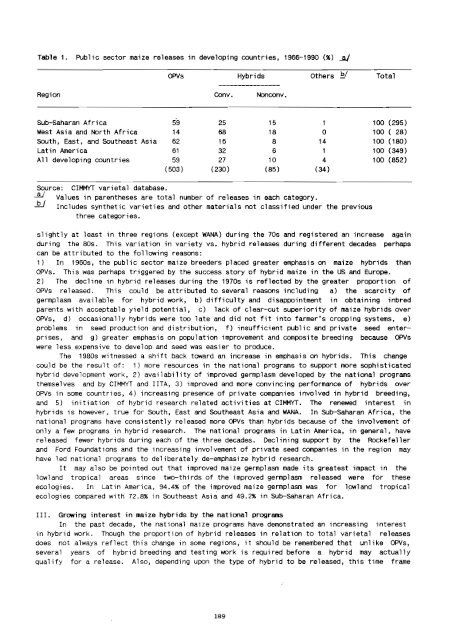Proceedings of the Fifth Asian Regional Maize Workshop - Search ...
Proceedings of the Fifth Asian Regional Maize Workshop - Search ...
Proceedings of the Fifth Asian Regional Maize Workshop - Search ...
Create successful ePaper yourself
Turn your PDF publications into a flip-book with our unique Google optimized e-Paper software.
Table 1. Public sector maize releases in developing countries, 1966-1990 (%) ~<br />
OPVs Hybrids O<strong>the</strong>rs E! Total<br />
----------------<br />
Region Conv. Nonconv.<br />
Sub-Saharan Africa 59 25 15 1 100 (295)<br />
West Asia and North Africa 14 68 18 0 100 ( 28)<br />
South, East, and Sou<strong>the</strong>ast Asia 62 16 8 14 100 (180)<br />
Latin America 61 32 6 1 100 (349)<br />
All developing countries 59 27 10 4 100 (852)<br />
(503) (230) (85) (34)<br />
Source: CIMMYT varietal database.<br />
~ Values in paren<strong>the</strong>ses are total number <strong>of</strong> releases in each category.<br />
~ Includes syn<strong>the</strong>tic varieties and o<strong>the</strong>r materials not classified under <strong>the</strong> previous<br />
three categories.<br />
slightly at least in three regions (except WANA) during <strong>the</strong> 70s and registered an increase again<br />
during <strong>the</strong> 80s. This variation in variety vs. hybrid releases during different decades perhaps<br />
can be attributed to <strong>the</strong> following reasons:<br />
1) In 1960s, <strong>the</strong> public sector maize breeders placed greater emphasis on maize hybrids than<br />
OPVs. This was perhaps triggered by <strong>the</strong> success story <strong>of</strong> hybrid maize in <strong>the</strong> US and Europe.<br />
2) The decline in hybrid releases during <strong>the</strong> 1970s is reflected by <strong>the</strong> greater proportion <strong>of</strong><br />
OPVs released. This could be attributed to several reasons including a) <strong>the</strong> scarcity <strong>of</strong><br />
germplasm available for hybrid work, b) difficulty and disappointment in obtaining inbred<br />
parents with acceptable yield potential, c) lack <strong>of</strong> clear-cut superiority <strong>of</strong> maize hybrids over<br />
OPVs, d) occasionally hybrids were too late and did not fit into farmer's cropping systems, e)<br />
problems in seed production and distribution, f) insufficient public and private seed enterprises,<br />
and g) greater emphasis on population improvement and composite breeding because OPVs<br />
were less expensive to develop and seed was easier to produce.<br />
The 1980s witnessed a shift back toward an increase in emphasis on hybrids. This change<br />
could be <strong>the</strong> result <strong>of</strong>: 1) more resources in <strong>the</strong> national programs to support more sophisticated<br />
hybrid development work, 2) availability <strong>of</strong> improved germplasm developed by <strong>the</strong> national programs<br />
<strong>the</strong>mselves and by CIMMYT and IITA, 3) improved and more convincing performance <strong>of</strong> hybrids over<br />
OPVs in some countries, 4) increasing presence <strong>of</strong> private companies involved in hybrid breeding,<br />
and 5) initiation <strong>of</strong> hybrid research related activities at CIMMYT. The renewed interest in<br />
hybrids is however, true for South, East and Sou<strong>the</strong>ast Asia and WANA. In Sub-Saharan Africa, <strong>the</strong><br />
national programs have consistently released more OPVs than hybrids because <strong>of</strong> <strong>the</strong> involvement <strong>of</strong><br />
only a few programs in hybrid research. The national programs in Latin America, in general, have<br />
released fewer hybrids during each <strong>of</strong> <strong>the</strong> three decades. Declining support by <strong>the</strong> Rockefeller<br />
and Ford Foundations and <strong>the</strong> increasing involvement <strong>of</strong> private seed companies in <strong>the</strong> region may<br />
have led national programs to deliberately de-emphasize hybrid research.<br />
It may also be pointed out that improved maize germplasm made its greatest impact in <strong>the</strong><br />
lowland tropical areas since two-thirds <strong>of</strong> <strong>the</strong> improved germplasm released were for <strong>the</strong>se<br />
ecologies. In Latin America, 94.4% <strong>of</strong> <strong>the</strong> improved maize germplasm was for l,owland tropical<br />
ecologies compared with 72.8% in Sou<strong>the</strong>ast Asia and 49.2% in Sub-Saharan Africa.<br />
III. Growing interest in maize hybrids by <strong>the</strong> national programs<br />
In <strong>the</strong> past decade, <strong>the</strong> national maize programs have demonstrated an increasing interest<br />
in hybrid work. Though <strong>the</strong> proportion <strong>of</strong> hybrid releases in relation to total varietal releases<br />
does not always reflect this change in some regions, it should be remembered that unlike OPVs,<br />
several years <strong>of</strong> hybrid breeding and testing work is required before a hybrid may actually<br />
qualify for a release. Also, depending upon <strong>the</strong> type <strong>of</strong> hybrid to be released, this time frame<br />
189

















